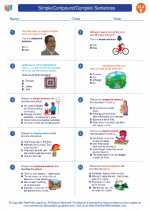Simple/Compound/Complex Sentences Study Guide
Simple Sentences
A simple sentence consists of a single independent clause. It expresses a complete thought and contains a subject and a verb. Simple sentences are often used to convey straightforward information.
Example: She ran to the store.Compound Sentences
A compound sentence consists of two or more independent clauses joined by a coordinating conjunction (such as and, but, or, so) and a comma. Compound sentences allow for the combination of related ideas into a single sentence.
Example: I like coffee, but she prefers tea.Complex Sentences
A complex sentence contains an independent clause and one or more dependent clauses. Dependent clauses cannot stand alone as complete sentences and are introduced by subordinating conjunctions (such as because, although, if, when). Complex sentences allow for the inclusion of additional information or dependent relationships within a sentence.
Example: Although it was raining, they decided to go for a walk.Study Guide Questions
- What is a simple sentence? Provide an example.
- How is a compound sentence formed? Give an example.
- Explain the structure of a complex sentence. Provide an example.
- Identify the coordinating conjunction in the following compound sentence: "I want to go to the movies, but my friends prefer staying in."
- Identify the subordinating conjunction in the following complex sentence: "When they arrived at the party, everyone cheered."
[Simple/Compound/Complex Sentences] Related Worksheets and Study Guides:
.◂English Language Arts Worksheets and Study Guides Fifth Grade. Simple/Compound/Complex Sentences

 Worksheet/Answer key
Worksheet/Answer key
 Worksheet/Answer key
Worksheet/Answer key
